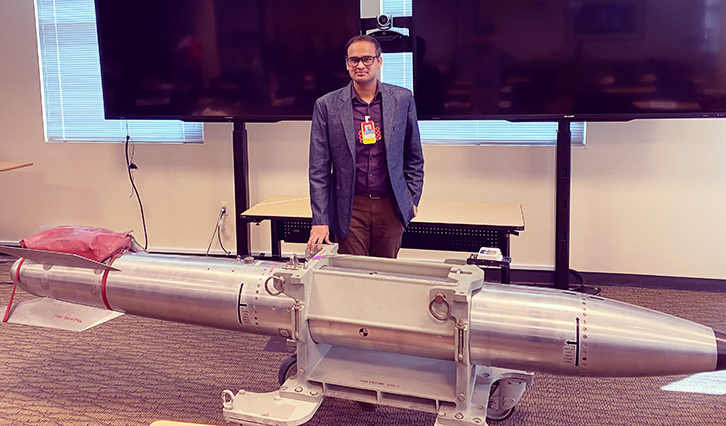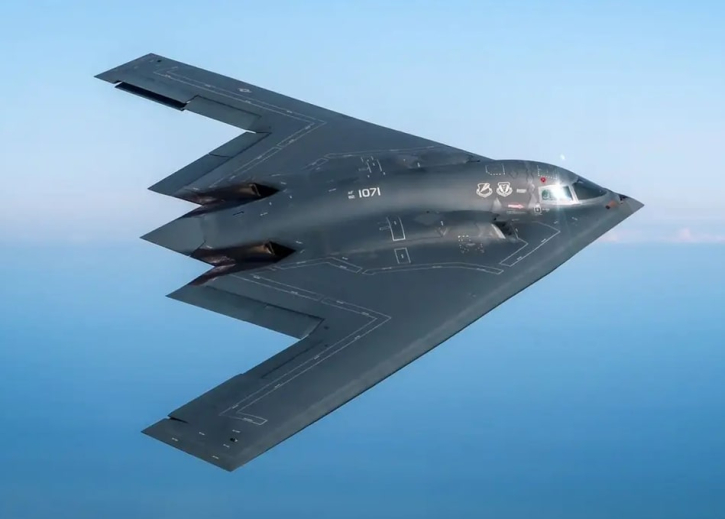Is Intelligence on Nuclear Breakout Trustworthy?


Kunal Singh PhD '25 is currently a Stanton postdoctoral fellow at Harvard Kennedy School's Belfer Center for Science and International Affairs. He joined MIT as a PhD student in the Department of Political Science in 2019. His decision to pursue academics was prompted by conversations he had with Vipin Narang, faculty director of the new Center for Nuclear Security and the Frank Stanton Professor of Nuclear Security. Singh describes his time at CIS, and as a student in the Security Studies Program, as providing him with steep intellectual development, mentorship, and friendship. (The photo above is courtesy of Kunal Singh and was taken at the Sandia National Laboratories in Albuquerque, New Mexico.)
The recent air strikes by Israel and the United States on nuclear infrastructure in Iran have revived disputes over intelligence on the imminence of a nuclear breakout—that is, how long it would take Iran to build its first nuclear weapon. In March, U.S. Director of National Intelligence Tulsi Gabbard reiterated the longstanding view in the American intelligence community that Iran had not yet decided to weaponize its nuclear capabilities. Israeli intelligence, on the other hand, indicated that Iran was not only accelerating its weaponization program but also planning for how to mate an explosive uranium core to a missile. It seems that President Donald Trump found the Israeli intelligence more convincing and decided that the United States would join in the air campaign started by Israel.
Much of the controversy over how close Iran was to breakout stems from the fact that intelligence reports tend to feed into a narrative justifying, or denying the grounds for, a preventive war on nuclear programs. This much is clear: No matter what the intelligence says about a potential nuclear breakout, the global nonproliferation architecture is harmed by preventive attacks. Rafael Mariano Grossi, the director-general of the International Atomic Energy Agency (IAEA) has stated, as have former directors-general Mohamed ElBaradei and Hans Blix, that nuclear facilities should not be attacked under any circumstances.
With that clarification out of the way, I would like to make two points that impinge directly on the recent attacks on Iran. First, intelligence about nuclear weapons programs carries uncertainty—and, in many cases, has turned out to be wrong. Second, intelligence about the imminence of a nuclear breakout almost always has a political component. It is often the case that motivated actors use this type of intelligence to justify their policy preferences. The intelligence that ultimately reaches the general public, mostly via news stories, has already been shaped by political actors who are involved in each step from data collection to interpretation and analysis.

A Northrop B-2 Spirit bomber, used by the U.S. in the recent airstrikes on Iran's nuclear infrastructure. Photo courtesy Wikipedia Commons.
The uncertainty of intelligence
The intelligence that feeds into counterproliferation decision-making is almost never an objective piece of fact, but rather an interpretation of raw data gathered by humans or equipment. This uncertainty implies that the decision to weaponize in Iran can never be fully understood by a foreign intelligence agency.
Moreover, even if analysts know, with a high degree of confidence, that the Iranian leadership has not decided to weaponize their nuclear capabilities, it does not mean that intelligence agencies would, in the future, be able to detect the moment a decision to weaponize is made. It is, therefore, imperative to understand how much time Iranian scientists and engineers would require to build a weapon if the supreme leader were to greenlight weaponization. John Ratcliffe, the director of the U.S. Central Intelligence Agency (CIA), has reportedly compared the non-decision to weaponize in Iran to football players who fight their way to the one-yard line but don’t attempt to score a touchdown.
The uncertainty inherent in intelligence includes the possibility of both false positives and false negatives. The debate over Iranian breakout has been dominated by the 2003 U.S. intelligence failure in which a false positive—or, more accurately, a fabricated positive alarm about Iraq manufacturing weapons of mass destruction—led to a costly invasion.
U.S. intelligence also has a history of false negative cases. In March 1993, the South African president, F. W. de Klerk, declared that his country had destroyed a small arsenal of nuclear weapons, the existence of which was largely unknown until that point. U.S. intelligence experts had suspected that South Africa possessed nuclear weapons but did not have concrete details. This intelligence failure occurred despite the Soviet Union detecting preparations for a nuclear test in the Kalahari Desert in July 1977 and passing the evidence to the United States before going public with it. The knowledge of test preparations did not automatically mean that intelligence agencies in the United States and the Soviet Union could discover the subsequent manufacturing of six atomic devices in South Africa.
In another example, U.S. intelligence agencies discovered test preparations at a nuclear site in Pokhran, India, in December 1995. The tests were postponed after Indian Prime Minister P.V. Narasimha Rao received a visit from the U.S. ambassador in New Delhi, Frank Wisner, and a phone call from President Bill Clinton. However, when the tests finally happened in May 1998, the United States was caught off guard.
Other states have also surprised U.S. intelligence agencies. Israel was able to build nuclear weapons by diverting spent fuel from the Dimona reactor and keeping it hidden from suspicious American inspection teams.
The CIA was puzzled by preparations for a nuclear test in 1964 in Lop Nur, China, because they did not believe the Chinese had enough weapons-grade plutonium to make a bomb. The CIA had completely missed that China was enriching uranium for its first nuclear bomb, ignoring the Chinese uranium enrichment facility at Lanzhou as an “incomplete and possibly incompleteable [sic] gaseous diffusion plant.” The United States and particularly Israel have much better penetration in Iran, but there is still no guarantee that a decision to weaponize would be discovered quickly.
The politics of intelligence
In addition to uncertainty, intelligence often has a political component. Those who see Iranian nuclear weapons as a big threat are likely to interpret any evidence as more dire than it is. They tend to exaggerate the advances made by Iran in its pursuit of the bomb, because they want to build a coalition to stop or delay Iran as soon as possible. As a small state in the Middle East, Israel perceives nuclear weapons in the possession of one of its regional adversaries as a much bigger threat than distant states in Europe and America do. Therefore, Israel tends to project a shorter timeline for Iran to reach the bomb. This Israeli tendency was also visible in response to the Iraqi and Syrian nuclear programs, which Israel bombed in 1981 and 2007, respectively.
The IAEA estimated that the Iraqi Osirak reactor could produce enough plutonium for one bomb every four years. However, Israel estimated that the reactor could produce that amount of plutonium every year. The Osirak reactor was under IAEA supervision, but the Israelis feared that the Iraqis would be able to divert spent fuel rods between two inspections. When the skeptics pointed out that French technicians at the reactor site would also present an obstacle to diversion, the Israelis retorted that a few French officials could be bribed by the Iraqis. In June 1981, the Israeli Air Force bombed and destroyed the Osirak reactor before the Iraqis could make it operational.
In 2007, similarly, the Israelis perceived Syrians to be more advanced in their pursuit of nuclear weapons than they actually were. The U.S. and Israeli intelligence agencies had not found a plutonium reprocessing facility and weaponization program—proof that Syria was indeed pursuing the bomb. Indeed, the CIA refused to say with high confidence that Syria’s al-Kibar reactor site was part of a nuclear weapons program. U.S. President George W. Bush told Israeli Prime Minister Ehud Olmert that he could not order a military attack on the Syrian reactor “unless my intelligence agencies stand up and say it’s a weapons program.” But unlike the United States, Israel was unwilling to wait for more evidence that the Bashar al-Assad regime was acquiring the bomb. For Israel, it was enough that Assad was building the al-Kibar reactor in secret, outside IAEA safeguards, with the help of North Korean scientists and engineers. The Israeli Air Force bombed and destroyed the reactor in September 2007 before it went operational.
High stakes warrant heightened skepticism
The costs of not asking questions about intelligence can be grave, especially when an ally with greater motivation for preventive attack is encouraging the use of military options. In 1963, Chiang Ching-kuo, the official who supervised Taiwan’s clandestine intelligence and paramilitary operations on mainland China, asked the United States for “transportation and technical assistance” in targeting Chinese “missile sites and atomic installations.” Chiang tried to persuade McGeorge Bundy, the U.S. national security advisor, that the attack should happen soon because “time is the key element.”
He also got an audience with President John F. Kennedy, who explored with Chiang the feasibility of infiltrating 300 to 500 men to attack Baotou, the site where the CIA believed China was housing a plutonium-producing reactor. Despite Chiang eagerly wanting to go ahead with the plan, Kennedy ended the meeting demanding “better intelligence” on the Chinese nuclear weapons program.
Kennedy’s instinct about the intelligence was right: U.S. intelligence agencies had misidentified a nuclear fuel component plant at Baotou as a reactor. The actual reactor was in the Jiuquan prefecture and the Chinese were relying on uranium enrichment, not plutonium reprocessing, for their first bomb. Faulty intelligence could have plunged the United States into a costly war with China in 1963. It is, therefore, incumbent upon both the general public and the key decision-makers to be skeptical about intelligence reports when the stakes are so high. Intelligence should come with a statutory warning about its uncertainty and potential bias.
This article was reprinted with permission by the Bulletin of the Atomic Scientists and was originally published here on July 8, 2025.